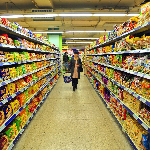Please find below the
Finalist Evaluation
Judges'' ratings
| • | Novelty: | |
| • | Feasibility: | |
| • | Impact: | |
| • | Presentation: |
Judges'' comments
The judges want to congratulate you on an excellent submission! They suggest you continue to consider their earlier comments more specifically, such as giving an explanation of how to account for portion size or preparation for strong resistance from agribusiness (e.g., beef lobby).
Semi-Finalist Evaluation
Judges'' ratings
| • | Novelty: | |
| • | Feasibility: | |
| • | Impact: | |
| • | Presentation: |
Judges'' comments
I love the idea of giving consumers broad categories about carbon impacts. I think this is much more promising than approaches that give lots of detail and attempt highly precise categories. I found this proposal exciting because of the streamlined approach. Furthermore, it focuses on a very highly carbon intensive set of products, and that is a big virtue (in contrast to other carbon calculators that attempt to cover all goods and services.) The proposal would have been strengthened by more emphasis on research and particularly the experience of UK grocery stores that have begun to use carbon accounting. How have they fared? I am also wondering about the efficacy of an online approach to grocery shopping. Most people shop for themselves and decisions are made in the store. I think a broad color coding approach should be implemented within the store. At a minimum an app to use in store. But what about actually trying to get a grocery retailer with a strong sustainability commitment to use not a virtual shelving system, but an actual one. The proposal would benefit from more detail and more engagement with the literature. I suggest looking at Dara O"Rourke's work and his experience with the Good Guide. It would also be interesting to incorporate a social influence dynamic into the app (see the work of Robert Cialdini.) More thought into who will use it and where is needed (in developing countries, less food is branded.) Also I think more attention to cost and timeline would be useful.
This proposal falls into the category of: provide consumer with information about the ecological impact of their purchases, and they will change their behaviors. I am generally a big skeptic of that approach with regard to material goods because it basically tells people “you can shop all you want as long as you choose this product over that”. It does not fundamentally change the culture of consumerism and produces marginal absolute benefits. But when it comes to food, the story is different. We do need to buy and consume food, and our choices can make a huge difference from the ecological perspective. Also, most people do not know the enormous ecological impact of, for example, beef. So I like this proposal. My suggestions to the authors for further improvements are as follows: if possible, include the information about the size of a portion that you assume in these scores. A meat lover may not be willing to eliminate meat or reduce the number of meat-eating days per week, but they may be willing to reduce their portions. As we all know, American portions of meat are ridiculously large. Second, to make this proposal workable you need to address the institutional issues. How would you address the resistance of the beef industry? How would you go about getting this proposal accepted by supermarkets or food regulatory agencies? Finally, draw on the past experiences of the places where this type of labelling has been tried.
No comments have been posted.
